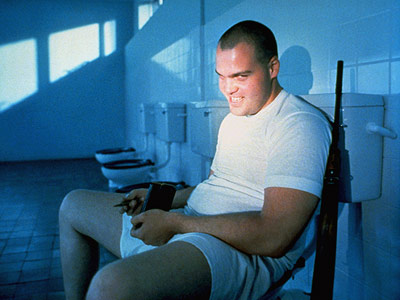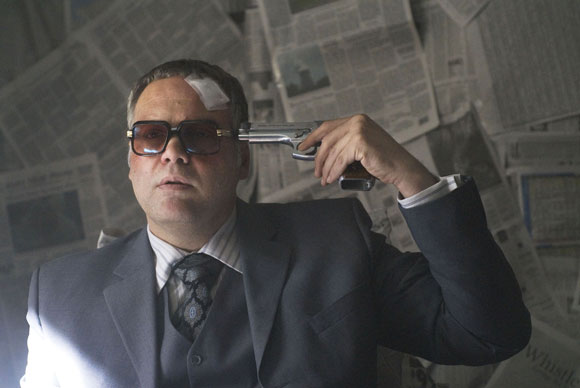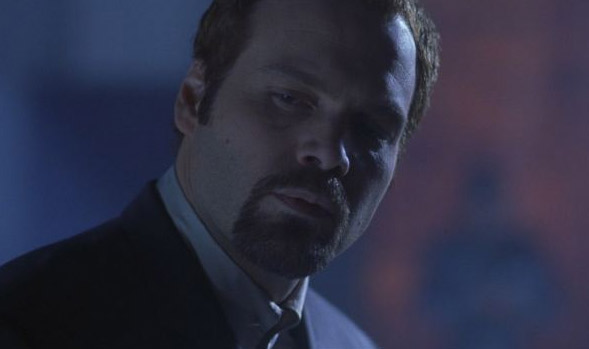 Craig here, back after a week away, with this week's Take Three. Today: Vincent D'Onofrio
Craig here, back after a week away, with this week's Take Three. Today: Vincent D'Onofrio
Take One: Full Metal Jacket (1987)
The first thing I think about when I think about Stanley Kubrick’s Full Metal Jacket is D’Onofrio’s face, sunken into a foul grimace by deep hatred – of himself and everything and everyone around him – as he sits on a toilet in the starkly Kubrickian military ‘head’ in the dead of night, loaded rifle by his side. “Hi joker,” he says, in a decidedly creepy fashion, as Matthew Modine shines a torch on his face. Somethin’s up. He’s not quite... there
I AM... in a world... of shit!”
This exchange draws us into one of the film’s most powerfully effective scenes, one that stays wedged in your mind. (Nothing in the film’s explosive second half is as powerful as this.) It’s D’Onofrio’s last scene in the film, his big, terrible, final moment. All the prolonged abuse and intense physical strain he’s endured up until this point is distilled into his words, his desperate and maniacal expression. Outside of R. Lee Ermy’s shouty Golden Globe-nominated grandstanding, D’Onofrio walks away with the acting honours. The physicality required (D’Onofrio added an extra 70lbs, beating DeNiro’s bulk-up for Raging Bull) is complemented by his proficiency in conveying the inner workings of a broken army soul. D’Onofrio’s Leonard “Gomer Pyle” Lawrence (nicknamed after a Jim Nabors character on The Andy Griffith Show) is key to understanding what Kubrick was getting at with the film. Full Metal Jacket’s best moments, and Kubrick's most pointed statements about war and military endeavor, are translated through his bold, grimly-evinced performance.
Take Two: Impostor (2001)
D’Onofrio was on the other side of the authority line in Gary Fleder’s 2001 sci-fi Philip K. Dick adaptation Impostor. As Detective Hathaway he manfully orders armed minions about in the desperate pursuit of Gary Sinise who is either an innocent-man-on-the-run or a replicant-on-the-lam. But from the off neither we nor D’Onofrio know what’s happening in the scattershot plot, so we bewilderedly follow along as Hathaway sniffs out his marked man.
Impostor was released the same year as another Dick flick Minority Report. It’s like the bargain-bin version of Spielberg’s high-end blockbuster; it’s apt to say D’Onofrio has the Colin Farrell role. He does plenty of yelling and a lot of strutting around the CGI landscapes. We’re meant to hate him because he distrusts Sinise but I think the hatred of the character had more to do with his pompous, intricately-trimmed goatee. But, the thing is, he’s the film’s most interesting presence. He’s sturdy and reliable, giving Impostor some generously hefty gravitas, whereas the other actors are as wonky as the plot. D’Onofrio often has a bolshy, superior lilt to his line readings, as if he’s watched a lot of John Malkovich films and discarded his sneery disdain and replaced it with concentrated bluntness. In fact, he’s arguably a groovier Malkovich: a character actor whose career can perhaps be loosely compared to his, but who’s more au fait with genre filmmaking, and with a funkier, more unpredictable edge. (Think of his kinky-icky work in The Cell, for example, against Malkovich’s down-the-line work in In the Line of Fire.) Any “name” actor could’ve portrayed Detective Hathaway but many would well have dialed it in. D’Onofrio gives it his full attention.

Take Three: Staten Island (2009)
D’Onofrio made a couple of NY-based crime flicks in 2009, coincidentally both co-starring Ethan Hawke: Brooklyn’s Finest and Take Three’s little-seen gem, Staten Island. (He now needs to complete this NY set with the other three boroughs.) It’s an odd criminal brew, both grisly and ridiculous, and with interweaving segments that follow a handful of interacting characters. D’Onofrio’s arc sees him as the magnificently named Parmie Tarzo, a crime kingpin of the titular isle, keen to make his mark in a unique way.
Rotten Tomatoes will tell you that it’s 22% good, but it’s a more interesting film than a low statistic will tell you, largely thanks to D’Onofrio. Mafiosa men in movies frequently get lauded as fearfully worthy of awe and respect – whether austere figures (Brando in The Godfather) or slick operators (DeNiro in Goodfellas) – but D’Onofrio goes for the absurd angle with an unsettling eccentricity. Tarzo’s soft-spoken but coldly stern and oh-so casually demented. This mob boss loves his mother and has industrial-sized delusions of grandeur which are an ill fit with his position in the community. In a bizarre quest for fame for himself – due to an attempt on his life, among other things – he seeks to enter the record books by dressing in an all-white suit while sitting in a tree in an attempt to save the local forest. You’d never have caught DeNiro or Brando do this on film. (Well ...Brando might’ve.) D’Onofrio himself says about Tarzo (in a Dailymotion video), “I think he’s pathetic...I gave him a lot of humility to carry around... I let him gain sympathy slowly, through his humility.” D'Onofrio's unusual portrait of Tarzo’s odd mob boss demeanor is Staten Island's most unique aspect. In the world of brilliant but ignored movie performances, D’Onofrio rules.
 Remember when D'Onofrio played "THOR" in Adventures in Babysitting?
Remember when D'Onofrio played "THOR" in Adventures in Babysitting?
Three more films for the taking: Men in Black (1997), The Thirteenth Floor (1999), Thumbsucker (2005)
Previously on Take Three: Alfre Woodard
